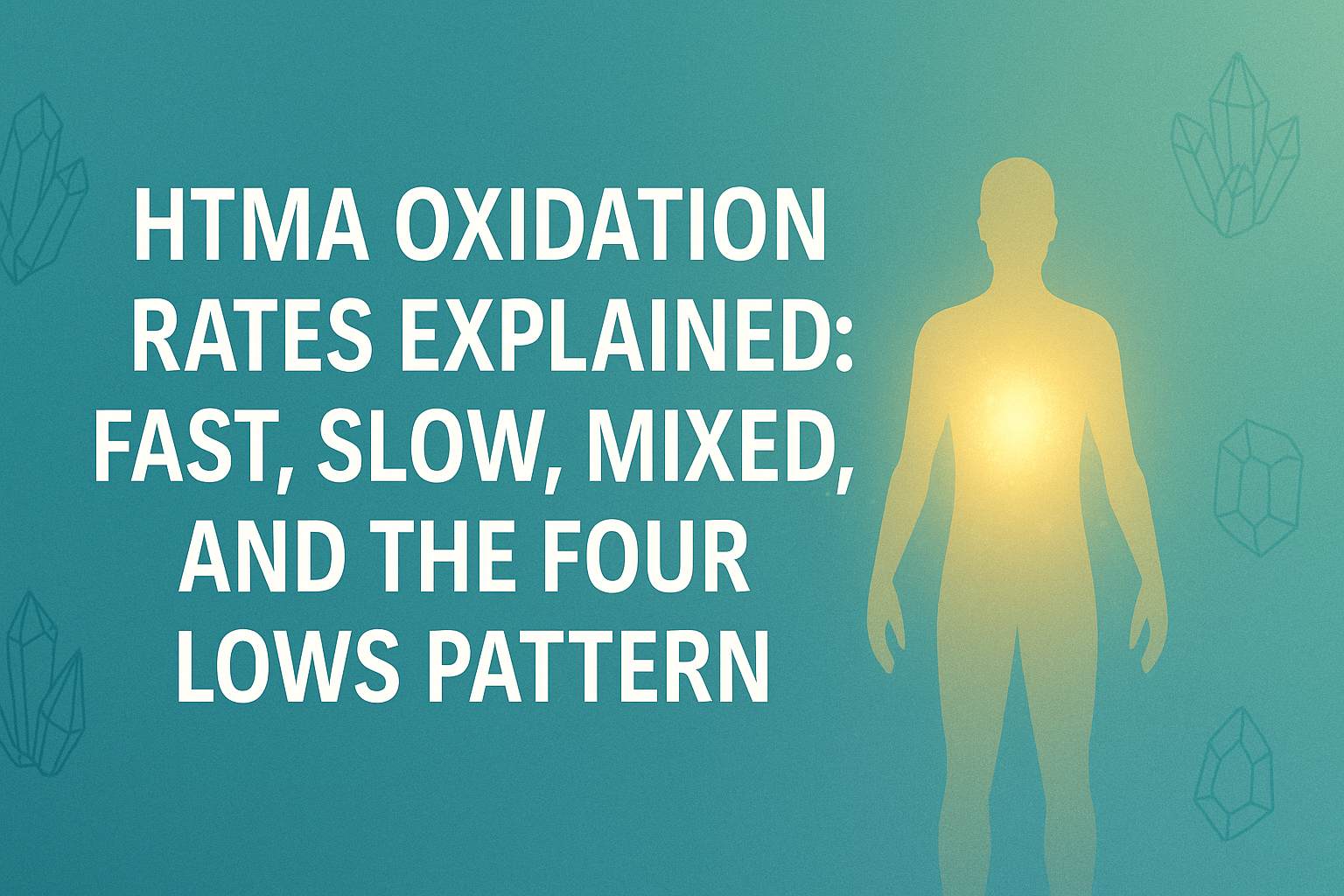Ever wonder why some people run on high energy while others feel stuck in slow motion? Hair Tissue Mineral Analysis (HTMA) reveals your oxidation rate — how efficiently your body converts food into energy.
There are four main patterns:
- Fast Oxidizer: the engine’s revving hot and fast
- Slow Oxidizer: the body is hitting the brakes to conserve energy
- Mixed Oxidizer: shifting between fast and slow, depending on stress and demand
- Four Lows Pattern: deep depletion, burnout, or a rebuilding phase
Each of these patterns gives insight into adrenal and thyroid function, your stress response, and how well your cells are using minerals — all seen through a simple hair sample.
Contents
- ⚡ Energy: Your Body’s Electricity
- 🧠 What Is Oxidation Rate, Really?
- 🕯️ Slow Oxidizers: When the Body Hits the Brakes
- 🔥 Fast Oxidizers: The Body in Overdrive
- ⚖️ Mixed Oxidizers: The Body in Transition
- 🪫 Four Lows Pattern: When the System Shuts Down
- ✨ Why Diet Needs Differ by Oxidation Type (The Metabolic Science)
- 🍽️ How to Eat for Your Oxidation Type
- 💊 Supplement Guidelines by Oxidation Type
- 🌟 The Takeaway: From Awareness to Action
- 🔍 Learn Your Oxidation Type
⚡ Energy: Your Body’s Electricity
Some people feel switched on — alert, active, ready to go. Others hit a slump every afternoon, no matter how much coffee they drink.
This isn’t just about sleep, willpower, or “trying harder.”
It comes down to how your body is producing energy at the cellular level — and that’s directly influenced by your oxidation rate.
As Dr. Paul Eck explained, “It is the balance of the minerals within the body that controls the rate at which energy is produced and used.”
In other words, your energy isn’t random — it’s chemical. Your mineral balance acts like a control panel, regulating how quickly your metabolism burns fuel, how your nervous system responds to stress, and even how clearly you think.
This relationship between minerals and metabolism is what Eck called your oxidation rate — the pace at which your body’s internal engine runs.
And when that pace is out of sync? You feel it — in your energy, mood, and motivation.
That’s where Hair Tissue Mineral Analysis (HTMA) comes in — it’s the window into your body’s oxidation rate, showing how your minerals are working together (or against you) to produce energy.
🧠 What Is Oxidation Rate, Really?
HTMA reveals your oxidation rate — the real reason your metabolism feels fast, slow, or stuck in between.
In simple terms, your oxidation rate describes how efficiently your body converts food into usable energy.
Think of it as the metabolic speed that powers every cell — influenced by your thyroid, adrenal glands, and the balance of key minerals like calcium, magnesium, sodium, and potassium.
Dr. Paul Eck — the biochemist who founded the science of Nutritional Balancing — discovered that your oxidation rate could be measured through mineral ratios in a hair analysis. Later, his colleague Dr. Lawrence Wilson expanded on Eck’s research, refining how these ratios reflect thyroid and adrenal activity.
Dr. Paul Eck discovered that your oxidation rate can be identified by examining two mineral ratios on a Hair Tissue Mineral Analysis (HTMA):
- Sodium-to-magnesium ratio (Na/Mg) — known as the adrenal ratio, reflecting adrenal gland activity.
- Calcium-to-potassium ratio (Ca/K) — known as the thyroid ratio, reflecting thyroid cellular effect.
These two ratios reveal how your glands and energy systems are working together — or not.
🔬 From These Ratios, Three Primary Metabolic Types Emerge
- Fast oxidation: Ca/K < 4 and Na/Mg > 4.17
→ Indicates strong adrenal output (high Na/Mg) and greater thyroid cellular effect (low Ca/K).
The body is burning fuel quickly — producing high energy but using it inefficiently. This is the classic “alarm stage of stress” described by Dr. Paul Eck. - Slow oxidation: Ca/K > 4 and Na/Mg < 4.17
→ Reflects reduced adrenal and thyroid activity (low Na/Mg and high Ca/K).
Calcium builds up in tissues while sodium and magnesium drop, slowing metabolism to conserve energy. This is often seen in chronic stress, burnout, or mineral depletion. - Mixed oxidation: one ratio fast and the other slow
→ Suggests the glands are out of sync — one pushing, the other braking.
This is an unstable and temporary metabolic state that typically resolves to either a fast or slow oxidation pattern within a few months, especially when supported by a targeted nutritional balancing program.
⚙️ The Mineral–Hormone Connection
When the adrenal glands are overactive, they release more aldosterone and cortisol, which raises tissue sodium and potassium levels — the hallmark of fast oxidation.
At the same time, this increased adrenal and thyroid activity causes calcium and magnesium to become more soluble and leave the tissues, leading to lower levels on a hair analysis.
In slow oxidation, the opposite occurs. Reduced adrenal and thyroid function leads to lower sodium and potassium, while calcium and magnesium accumulate in tissues — a kind of biochemical “armor” that slows cellular metabolism even further.
The balance between these four minerals forms the core of your oxidation pattern and determines how efficiently your body produces energy, manages stress, and recovers.
🔬 In a Nutshell
| Gland Activity | Na & K | Ca & Mg | Oxidation Rate |
|---|---|---|---|
| Adrenals + Thyroid overactive | ↑ High | ↓ Low | Fast oxidation |
| Adrenals + Thyroid underactive | ↓ Low | ↑ High | Slow oxidation |
This interplay of minerals and hormones is why HTMA is so revealing — it doesn’t just show nutrient levels, it shows how your glands are functioning.
Dr. Eck described it as reading “the electrical system of the human body,” where minerals act as conductors that translate glandular signals into energy output.
🌱 Oxidation Rate and Life Cycle
Your oxidation rate isn’t fixed — it changes as you move through life.
True fast oxidation is most common in babies and young children (up to about age 8). Their bodies have abundant natural energy which keeps metabolism running fast.
As children grow older, this high-energy state gradually slows down. By the time most people reach adulthood, around 80–85% shift into slow oxidation — a lower-energy state often linked with stress, nutrient depletion, and reduced adrenal and thyroid function.
Sometimes adults appear to be in temporary fast oxidation, but it’s usually the body’s response to stress, stimulants (like caffeine or sugar), or toxic metals — not true vitality. Once the stress is removed, the system typically drops back into slow oxidation.
This natural slowing reflects how our energy systems adapt over time — from the rapid growth of childhood to the conservation and repair mode of adult life.
🧩 Why It Matters
Understanding your oxidation rate helps you see that your symptoms aren’t random — they’re part of a metabolic pattern.
As Dr. Wilson explained, “In may cases, a person does not have 10 or 20 separate problems. One simply is in a metabolic type that carries all of these symptoms together.”
When you balance the oxidation rate, energy production improves, stress tolerance increases, and symptoms across the board begin to resolve naturally.
🕯️ Slow Oxidizers: When the Body Hits the Brakes
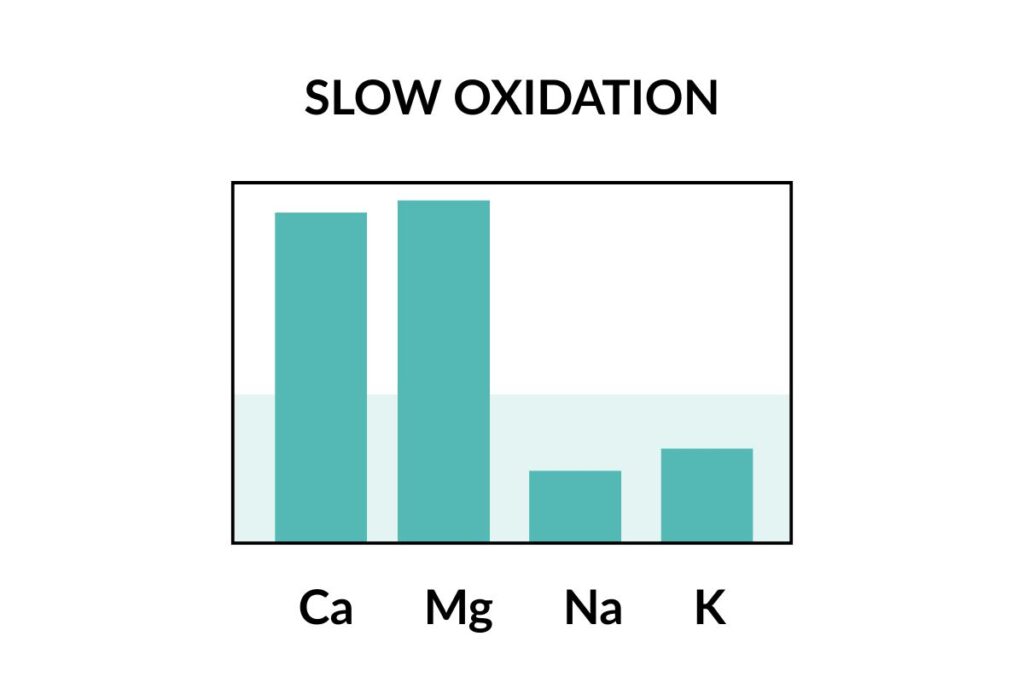
Slow oxidation represents a low-energy metabolic state, often reflecting exhaustion of the adrenal and thyroid glands. It shows up when the thyroid ratio (Ca/K) is above 4 and the adrenal ratio (Na/Mg) is below 4.17 — a combination that points to reduced glandular activity and slower cellular energy production.
Dr. Eck called slow oxidation “identical to the exhaustion stage of stress.”
The sympathetic nervous system — which normally drives alertness and energy — slows down, leaving the parasympathetic system dominant.
While that sounds restful, it’s actually an unhealthy parasympathetic state marked by low energy output and poor cellular regeneration.
As Dr. Wilson notes, “Without sufficient energy, the body is unable to repair and regenerate itself fast enough.”
🧪 The Mineral and Hormone Connection
On an HTMA chart, slow oxidation typically looks like this:
- High calcium and magnesium
- Low sodium and potassium
Biochemically, this reflects sluggish adrenal and thyroid function.
When adrenal output drops, aldosterone and cortisol production decline — leading to sodium loss and poor potassium regulation.
At the same time, low thyroid activity slows calcium metabolism, causing calcium to accumulate in tissues.
Dr. Eck explained this as the body “armoring” itself with calcium — a protective but energy-draining response.
The result? A body that’s chemically braked — conserving rather than producing energy.
As Eck described in Energy, when sodium and potassium are too low, the body “loses its solvents,” and minerals begin to precipitate out — depositing in arteries, joints, and tissues. You become less flexible. In other words, you age prematurely.
He compared it to a woodstove not getting enough air: the fire cools, combustion is incomplete, and residues build up until the flame nearly goes out.
💡 The Experience of a Slow Oxidizer
People with this pattern often feel:
- Fatigue and apathy
- Low blood pressure and blood sugar
- Cold hands and feet
- Dry skin or hair
- Brain fog or slower thinking
- Poor digestion or constipation
They rarely sweat, feel easily chilled, and may struggle with motivation or low mood.
Long-term slow oxidation increases susceptibility to infections, osteoporosis, skin problems, and even cancer — conditions linked to poor tissue repair and sluggish detoxification.
🌿 What Causes Slow Oxidation
Several factors push the body into this low-energy state:
- Chronic stress and overwork (adrenal burnout)
- Diets low in animal protein or cooked vegetables
- Excess fruit and sugar intake, which exhaust the glands
- Toxic metals such as copper or mercury
- Emotional suppression and structural tension
These stressors reduce glandular output, slow oxidation, and cause minerals to shift out of balance.
🔥 How to Support a Slow Oxidizer
The primary goal is to gradually rebuild adrenal and thyroid energy output, rather than stimulate it.
See the “How to Eat for Your Oxidation Type” section below for diet guidance, and the “Supplement Guidelines by Oxidation Type” section for targeted nutritional support.
🔥 Fast Oxidizers: The Body in Overdrive
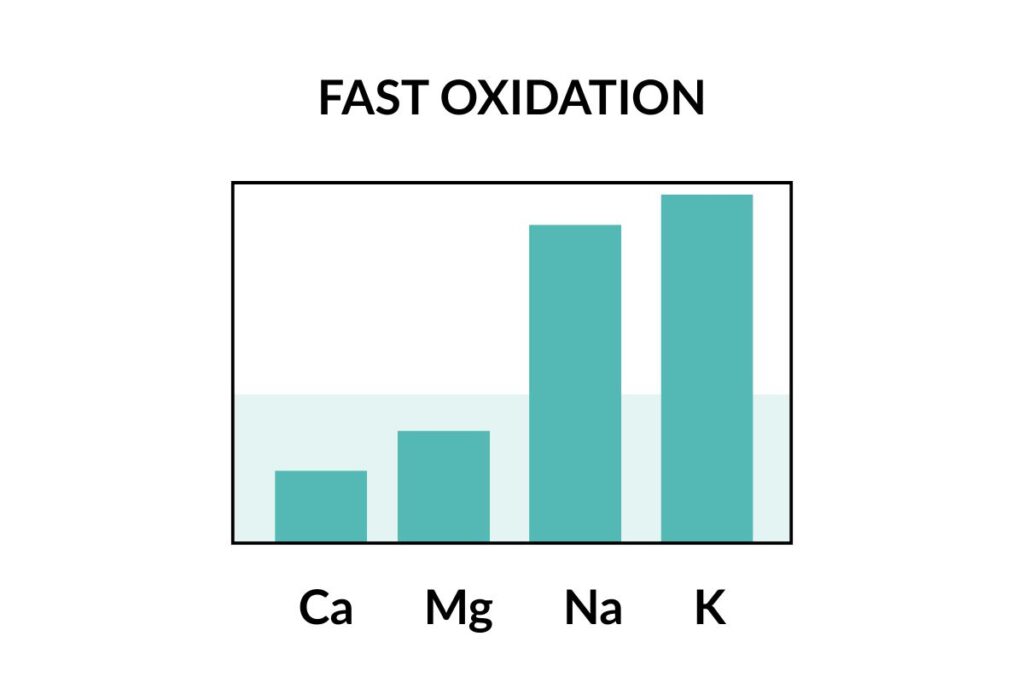
Fast oxidation is the alarm stage of stress — the body’s fight-or-flight mode turned up too high. Dr. Eck described it as a state of sympathetic nervous-system dominance, when the adrenals and thyroid glands are pushing energy production beyond what’s sustainable.
🧪 The Mineral Ratios
- Ca/K ratio < 4 → thyroid overactivity
- Na/Mg ratio > 4.17 → adrenal hyperactivity
On an HTMA, this looks like low calcium and magnesium (the body’s brakes) with high sodium and potassium (the accelerator). These patterns reveal that the adrenal cortex is secreting large amounts of aldosterone and cortisol, while the thyroid is producing more T3 and T4. The result is a faster rate of oxidation — the body burns fuel rapidly, often inefficiently, and tires easily once reserves run low.
Dr. Eck noted that sodium reflects adrenal output, while calcium reflects thyroid control. When sodium and potassium are high, the adrenals are pouring out stimulating hormones. When calcium and magnesium are low, the cell membranes become too permeable, letting metabolism “run hot.” It’s like revving an engine in neutral — lots of movement, little traction.
⚙️ The Physiology of a Fast Oxidizer
In this alarm phase, adrenaline floods the system to mobilize glucose and fatty acids for quick energy. The heightened sympathetic tone raises blood pressure, increases heart rate, and accelerates metabolism. Yet, fast adrenal glands can be just as inefficient as slow adrenal glands when overstressed.
Initially, this creates higher energy levels — but the energy is temporary and dissipates quickly. Prolonged fast oxidation eventually depletes magnesium, zinc, and other stabilizing minerals, setting the stage for anxiety, inflammation, and cardiovascular strain.
As Dr. Eck put it, “A fast oxidizer releases energy too quickly. He is like a wood stove with a fire that is burning too fast, overheating the room (the body), and running out of fuel. His oxidation rate must be decreased.”
When both the adrenals and thyroid are firing together, the system can overheat — and learning to balance those minerals is the key to sustainable energy.
💡 The Experience of a Fast Oxidizer
Fast oxidizers often feel:
- Anxious, restless, or impatient
- Hot or easily overheated
- Hungry often, craving fats and salts
- Alert but unable to relax
- Tense muscles or headaches
Fast oxidizers tend to be anxious, irritable, in a hurry, and aggressive. They are in a fight-or-flight mode too much of the time. This constant sympathetic charge burns through nutrients and leads to issues like high blood pressure, heart strain, arthritis, and panic attacks.
🌿 Causes of Fast Oxidation
- Stress and adrenaline dominance
- High sugar intake or low fat intake
- Personality traits — driven, high-achieving, easily frustrated
- Toxic metals that irritate adrenal function (e.g., copper, cadmium)
Diets too low in fats and too high in sugars can push the body into fast oxidation, forcing glands to work harder for quick energy bursts that soon crash.
🥑 How to Support a Fast Oxidizer
The aim is to stabilize and calm the metabolism so energy becomes steady rather than spiking and crashing.
See the “How to Eat for Your Oxidation Type” section below for diet guidance, and the “Supplement Guidelines by Oxidation Type” section for targeted nutritional support.
⚖️ Mixed Oxidizers: The Body in Transition
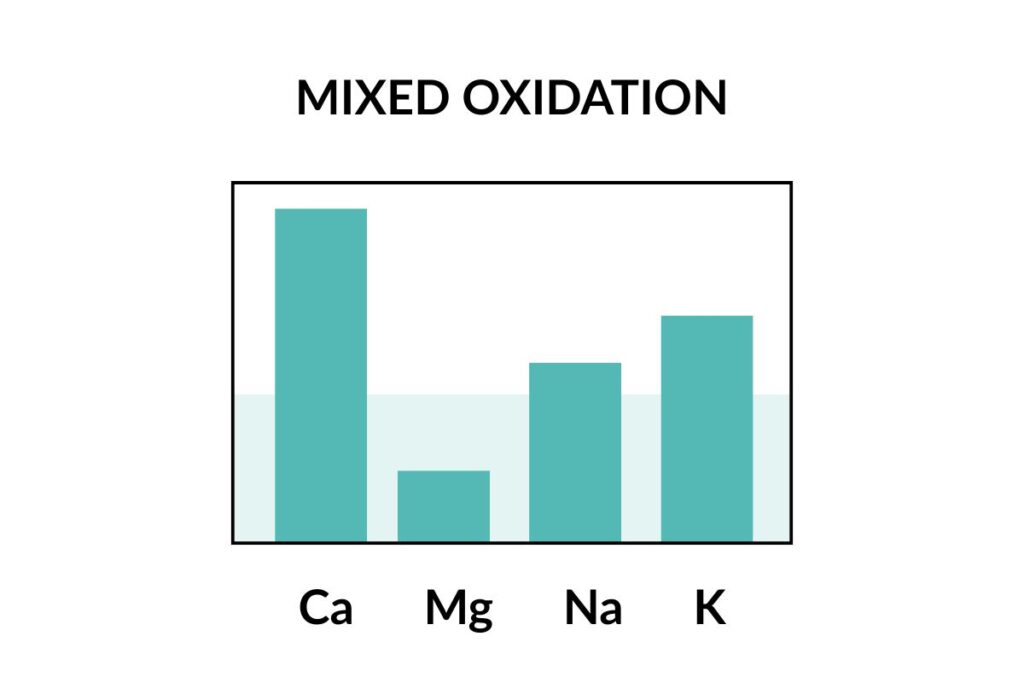
A mixed oxidation rate means your body is sending signals from both ends of the metabolic spectrum — part fast, part slow.
In HTMA terms, this happens when one mineral ratio indicates fast oxidation and the other shows slow oxidation. One system is pressing the gas, while the other is riding the brakes.
Mixed oxidation is a temporary and transitional state.
With proper support, it typically resolves into either a fast or slow oxidation pattern within a few months — especially when guided by a targeted nutritional balancing program that steadies both adrenal and thyroid activity.
🔬 The Biochemistry Behind It
A fast adrenal ratio (Na/Mg > 4.17) reflects elevated adrenal activity and sympathetic stress response — A fast adrenal ratio (Na/Mg > 4.17) reflects elevated adrenal activity and a strong sympathetic stress response — the alarm stage of stress Dr. Eck described. In this state, the body mobilizes energy rapidly through increased aldosterone and cortisol output.
At the same time, a high thyroid ratio (Ca/K > 4) points to sluggish thyroid performance, meaning calcium is accumulating in tissues and metabolism can’t fully keep up.
This mismatch creates biochemical “cross-talk”:
The adrenals shout: “Go faster!”
The thyroid whispers: “Slow down — we can’t keep up.”
Similarly, a slow adrenal ratio (Na/Mg < 4.17) — showing reduced adrenal output — combined with a low thyroid ratio (Ca/K < 4) — indicating an excessive thyroid cellular effect — also produces a mixed oxidation state.
In both cases, the body is out of rhythm, with the glands operating at different speeds. This creates unstable energy production, mood swings, and variable stress tolerance.
🌡️ Fast-Mixed vs. Slow-Mixed Patterns
If the ratio that was fast was relatively further away from the ideal than the ratio that was slow, you’re showing a fast-mixed oxidation rate — leaning toward sympathetic dominance.
This version of mixed oxidation feels like classic fast oxidizer symptoms:
- Anxiety, irritability, restlessness
- Racing thoughts or heart palpitations
- Warm body temperature, quick to sweat
- Blood-pressure spikes or sleep trouble
It’s the body in a fight-or-flight mode that flickers, unable to sustain the drive for long.
Conversely, if the ratio that was slow was relatively further away from the ideal than the ratio that was slow, you’re in a slow-mixed oxidation rate, leaning closer to exhaustion.
That feels more like slow oxidizer traits:
- Fatigue, apathy, or depression
- Feeling cold, sluggish digestion
- Low motivation, dry skin, or constipation
In both cases, energy production is uneven — surges followed by crashes, alertness followed by burnout.
🧭 Why It Matters
Mixed oxidation patterns are less stable than pure fast or slow types.
Because the glands are firing inconsistently, your metabolism can swing back and forth depending on stress, diet, or rest.
That’s why retesting your HTMA every three months is ideal — it helps track whether your body is stabilizing toward fast or slow oxidation.
Most people resolve a mixed pattern within a few months on a consistent nutritional-balancing program.
🌿 Supporting a Mixed Oxidizer
Mixed oxidation requires restoring rhythm between the thyroid and adrenal glands and stabilizing energy swings.
See the “How to Eat for Your Oxidation Type” and “Supplement Guidelines by Oxidation Type” sections below for specific nutritional strategies.
🪫 Four Lows Pattern: When the System Shuts Down
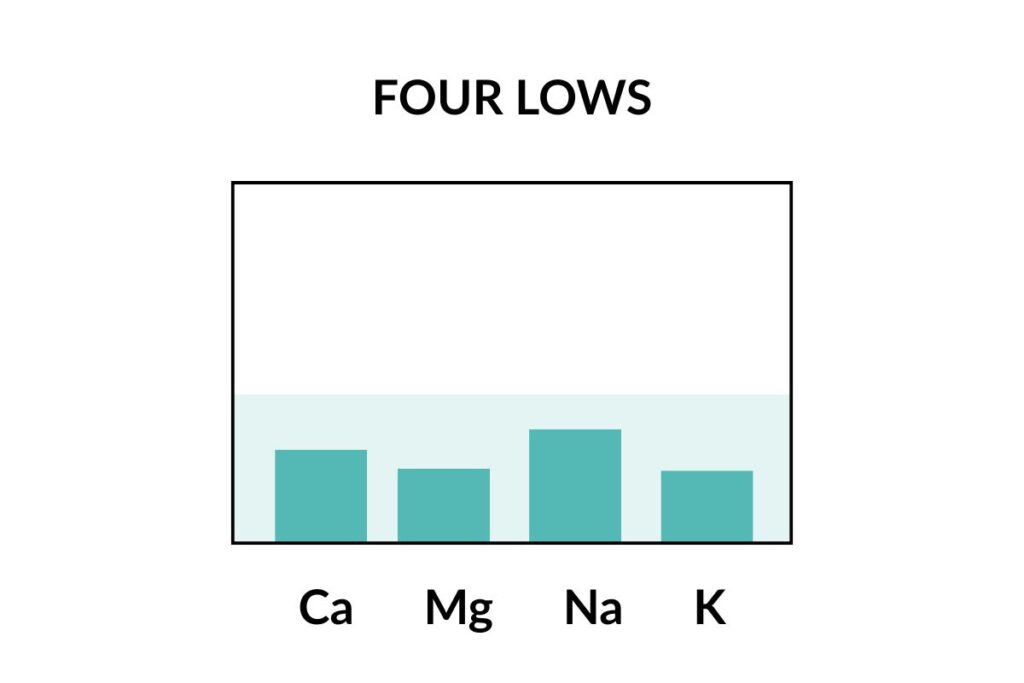
The Four Lows pattern is one of the most challenging — and misunderstood — findings on a Hair Tissue Mineral Analysis (HTMA).
It occurs when all four major electrolytes — calcium, magnesium, sodium, and potassium — fall below their ideal levels.
| Mineral | Ideal Range (mg%) | Four Lows Pattern |
|---|---|---|
| Calcium | 40+ | ↓ Below 40 |
| Magnesium | 6+ | ↓ Below 6 |
| Sodium | 25+ | ↓ Below 25 |
| Potassium | 10+ | ↓ Below 10 |
This pattern reflects adrenal insufficiency, burnout, and deep exhaustion.
Dr. Paul Eck called it a “dead battery” state — when the body has slowed its metabolism to the lowest possible setting in order to conserve the little energy it has left.
But there’s another side to it: in some people, Four Lows can also appear temporarily during healing, when the body is releasing toxins and recalibrating energy systems.
So while it can look like collapse, it can also be part of deep repair — a pause before renewal.
🔬 What’s Happening Biochemically
When all four of these electrolytes are low, it usually means:
- Adrenal and thyroid glands are depleted and producing very low hormone output.
- Cell membranes are less permeable, making it harder for nutrients to enter cells.
- Energy production is minimal, so detoxification and digestion slow down.
- The body is malnourished and often toxic, due to both poor absorption and chronic stress.
This pattern can also stem from gut and microbiome imbalances, which reduce the body’s ability to absorb nutrients from food.
Dr. Wilson noted that individuals in Four Lows are “usually quite toxic,” with stored metals like copper and lead blocking energy pathways.
Because the body is exhausted, it often craves stimulants — caffeine, tobacco, or high-dose B vitamins — as quick ways to boost energy.
But those quick fixes only drain reserves further, pushing the body deeper into burnout.
Dr. Wilson reminds us that you can’t push your way out of a Four Lows pattern. Recovery happens slowly — through nourishment, rest, and steady support from a targeted nutritional balancing program.
💡 How It Feels
People with Four Lows often describe feeling:
- Chronically tired — even after sleep
- Anxious or wired but without real energy
- Muscle cramps or tightness
- Food sensitivities or allergies
- Digestive issues and malabsorption
- Brain fog and mood swings
Over time, if uncorrected, this can lead to degenerative conditions, as the body simply lacks the mineral reserves to repair itself.
🌱 The Emotional Layer
Dr. Wilson observed that many Four Lows patterns arise from prolonged emotional strain — especially from inner tension, guilt, anger, or fear.
Common lifestyle patterns include:
- Working too hard or living under constant pressure
- Being overly self-critical or perfectionistic
- Feeling trapped, oppressed, or unable to rest
These mindsets mirror the biochemical picture: the body is trying to protect itself from further depletion by shutting down nonessential systems until it’s safe to rebuild.
If this pattern appears on a first test, it signals that the body needs profound rest, nutrition, and emotional release.
But if it appears on a retest during a nutritional balancing program, it can actually be a celebration pattern — showing that the body is finally slowing down enough to heal deeply.
🌿 Supporting the Four Lows Pattern
Four Lows requires gentle, consistent, non-stimulating support.
See the “How to Eat for Your Oxidation Type” and “Supplement Guidelines by Oxidation Type” sections below for recommended nutrition and supplement considerations.
🌞 In Short
The Four Lows pattern may look like failure, but it’s often a protective recalibration.
It’s the body’s way of saying:
“I’ve been running on empty. I’m stopping now so I can start again — stronger.”
With time, support, and the right program, this “shutdown” phase can become a doorway to deeper healing and a sustainable return of true vitality.
✨ Why Diet Needs Differ by Oxidation Type (The Metabolic Science)
Your oxidation rate reflects how efficiently your cells convert food into energy in the mitochondria.
All food eventually feeds into the Krebs cycle (your internal energy generator), but it arrives through two main pathways:
| Nutrient | Converts To | Role |
|---|---|---|
| Carbohydrates & Protein | Pyruvate | Enters the Krebs cycle if paired with acetyl-CoA |
| Fats | Acetyl-CoA | Combines with pyruvate to produce ATP (usable energy) |
To produce steady energy (ATP), the body needs a balance of pyruvate and acetyl-CoA.
This is exactly where oxidation rate changes nutritional needs.
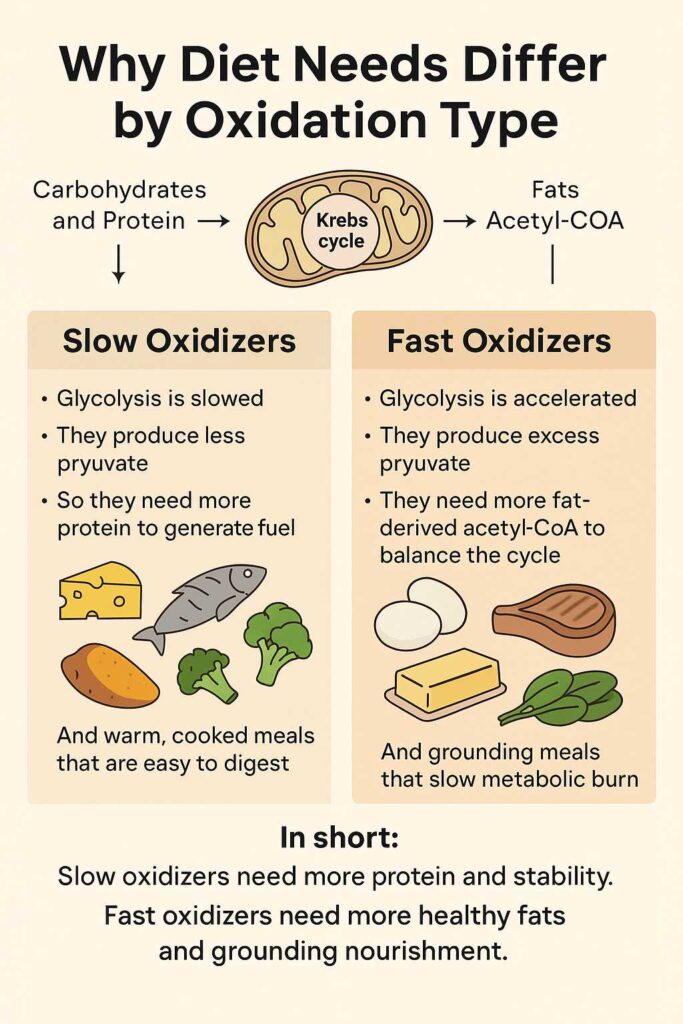
🐢 Slow Oxidizers
The metabolic flame is burning low.
- Glycolysis runs slowly → less pyruvate is produced
- The Krebs cycle doesn’t receive enough fuel
- Energy feels low and inconsistent
Common feelings:
- Cold hands and feet
- Low motivation, foggy thinking
- Fatigue despite rest
Diet Focus for Slow Oxidizers
Goal: Rebuild metabolic fire steadily.
- More protein
Supplies pyruvate and the B-vitamins needed for Krebs cycle function. - Warm, grounding carbohydrates
Root vegetables, squashes, and whole grains help stabilize blood sugar. - Cooked vegetables (2–3 cups/day)
Provide potassium, magnesium, and are easier to digest when metabolism is slow.
Protein + warm carbs = energy restoration.
🔥 Fast Oxidizers
The metabolic flame is burning too quickly.
- Glycolysis runs fast → excess pyruvate floods the system
- If there’s not enough acetyl-CoA from fats, that pyruvate turns into lactic acid
- This creates irritability, heat, anxiety, and mineral depletion
Common feelings:
- Wired but tired
- Hungry often
- Overheated or anxious
- Quick to fatigue after exertion
Diet Focus for Fast Oxidizers
Goal: Slow and steady the burn.
- Healthy fats (ghee, eggs, butter, coconut oil, fatty meats)
Provide acetyl-CoA to pair with pyruvate and stabilize the Krebs cycle. - Moderate protein
Supports structure without accelerating metabolism. - Cooked vegetables (2–3 cups/day)
Provide calming alkaline minerals that reduce overdrive.
Healthy fats + slow carbs = grounded energy.
🔥🔥 In Short
| Oxidation Type | Metabolic Pattern | Krebs Cycle Issue | Best Dietary Support |
|---|---|---|---|
| Slow Oxidizer | Low energy burn | Not enough pyruvate | More protein + warm steady carbs + cooked vegetables |
| Fast Oxidizer | High energy burn | Excess pyruvate without enough acetyl-CoA | Healthy fats + grounding protein + cooked vegetables |
The guiding principle:
Slow oxidizers need to feed and warm the flame.
Fast oxidizers need to steady and cool the flame.
And cooked vegetables help both, because they supply the minerals required to regulate energy production.
🍽️ How to Eat for Your Oxidation Type
Your oxidation type reflects how quickly or slowly your body converts food into usable energy.
By matching your meals to your metabolic pattern, you reduce stress, stabilize blood sugar, and support adrenal + thyroid recovery instead of forcing energy the body doesn’t have.
🐢 Slow Oxidizer Diet
Slow oxidation is a low-energy metabolic state. The goal is to rebuild metabolic “fire” gently and steadily.
Eat:
- High-quality animal protein at 2+ meals/day
(supports adrenal and thyroid activity) - Moderate carbohydrates
Root vegetables, whole grains, legumes - 2–3 cups cooked vegetables per meal
Supports mineral replenishment and digestion
Limit:
- Added fats and oils
Slow oxidizers do not require extra fat; too much slows metabolism further - Raw/cold foods (hard to digest and energy-draining)
- Smoothies, fruit juice, caffeine, chocolate, stimulating herbs
Goal:
⭐ Warm, grounding meals to rebuild energy — not stimulate it.
🔥 Fast Oxidizer Diet
Fast oxidation means the metabolic “fire” burns too quickly. The goal is to slow and stabilize energy release.
Eat:
- Good-quality fats at each meal
Add 1–2 tablespoons of:
butter, ghee, cream, egg yolks, beef/lamb fat, roasted almond butter, tahini, extra-virgin olive oil - Daily animal protein
- Plenty of cooked vegetables
To supply calming alkaline minerals
Limit:
- Excess carbohydrates, especially sugars and refined starches
(they accelerate metabolic speed)
Goal:
⭐ Slow burn → steady energy, emotional calm, stable blood sugar.
⚖️ Mixed Oxidizer Diet
Mixed oxidation shows a metabolism in transition.
If leaning fast-mixed:
→ Follow the Fast Oxidizer Diet (more fats, fewer carbs)
If leaning slow-mixed:
→ Follow the Slow Oxidizer Diet (more protein, moderate carbs, limited fats)
Goal:
⭐ Consistency > intensity.
Mixed states stabilize when meal patterns are steady and predictable.
🪫 Four Lows Diet
A Four Lows pattern reflects deep metabolic depletion. The body cannot be pushed — it must be supported.
Diet Pattern:
Follow the diet for whichever oxidation type is dominant:
| Four Lows Variation | Diet to Follow |
|---|---|
| Slow-Four Lows | Slow Oxidizer Diet |
| Fast-Four Lows | Fast Oxidizer Diet |
Your HTMA report or practitioner interpretation indicates direction.
Across all Four Lows:
- Choose warm, cooked, mineral-rich meals
- Include protein at every meal
- Use sea salt to support adrenal mineral balance
Strictly avoid stimulants:
Caffeine, chocolate, energy drinks, sugary foods, fruit juices, pre-workout stimulants, and stimulating herbs.
These create short spikes of false energy that drain adrenal reserves further.
Goal:
⭐ Do not push. Nourish → Stabilize → Allow energy to return gradually.
✅ Quick Summary Table
| Oxidation Type | Core Fuel Strategy | Avoid | Main Goal |
|---|---|---|---|
| Slow Oxidizer | Protein + moderate carbs + cooked veg | Added fats & stimulants | Rebuild metabolism |
| Fast Oxidizer | Extra fats + protein + cooked veg | High carbs & sugars | Slow and stabilize |
| Mixed | Follow direction of shift | Extreme dietary swings | Restore rhythm |
| Four Lows | Follow Fast or Slow diet (direction-based) | All stimulants | Nourish without pushing |
💊 Supplement Guidelines by Oxidation Type
Supplements are adjusted every 3–4 months based on HTMA retesting, as mineral patterns shift throughout the healing process. These changes are best guided by a practitioner, who can consider your HTMA chart, individual health status, symptoms, and lifestyle to ensure the body is supported rather than pushed.
🐢 Slow Oxidizers
Focus on rebuilding the metabolic “flame” and restoring energy production.
In slow oxidation, adrenal and thyroid output are low, sodium and potassium are depleted, and calcium often becomes bio-unavailable (stored in tissues where it can’t be used).
The goal is to restore mineral movement, not simply add more.
Supportive nutrients often include:
- Adrenal Support
Helps restore sodium and potassium balance, stabilize blood sugar, and rebuild stress tolerance. Gentle, steady support—not stimulants. - Thyroid Support
Encourages stored calcium to move back into a usable form and gently lifts metabolism without over-driving it. - Zinc (guided by ratios)
Often low relative to copper in slow oxidizers; supports adrenal enzymes, immune strength, and emotional steadiness. - Multivitamin including B-Vitamins (especially B1, B2, B3), Vitamin C and Trace Minerals
Needed for Krebs cycle energy production and carbohydrate metabolism; slow oxidizers often struggle to convert food into fuel without these. - Vitamin C
Supports adrenal repair and helps clear stored copper, which is common in slow oxidation. - Calcium + Magnesium (balanced)
Slow oxidizers often show high calcium on the chart but low cellular access to it; when paired with magnesium and adrenal support, calcium becomes usable rather than stuck in tissues. - Kelp (trace minerals + natural iodine): Helps gently support thyroid activity and replenishes trace minerals that are often depleted in slow oxidation. Useful for restoring metabolic warmth and improving energy without stimulation.
- GB3 (bile salts + digestive enzymes): Slow oxidizers commonly have sluggish digestion and low stomach acid. GB3 improves protein and fat breakdown, reduces bloating, and enhances nutrient absorption so the body can actually use the minerals it’s given.
🔥 Fast Oxidizers
Focus on slowing and stabilizing the metabolic rate while replenishing nutrients that are rapidly burned in states of high adrenal output.
Supportive nutrients often include:
- Calcium + Magnesium
Ground and stabilize the nervous system to reduce sympathetic overdrive. - Bioavailable Copper (guided by ratios)
Fast oxidizers tend to burn through copper quickly, leaving tissues low even when total copper is high. Restoring usable copper supports adrenal steadiness, blood sugar balance, and emotional regulation. - Thymus Support
Because thymus function is copper-dependent, supporting the thymus can help regulate immunity, calm reactivity, and stabilize stress physiology. - Vitamin D
Helpful when calcium utilization is impaired. Supports proper calcium placement in tissues rather than allowing it to remain unregulated. - Kelp (trace minerals + natural iodine): Supports thyroid balance, replenishes trace minerals lost through fast metabolic “burn,” and helps stabilize energy output.
- GB3 (bile salts + digestive enzymes): Enhances fat digestion, supports bile flow, reduces bloating, and helps fast oxidizers actually use the healthy fats they need for steady energy.
⚖️ Mixed Oxidizers
Adjust gradually according to direction of shift.
🪫 Four Lows
Low-dose, gentle support only.
In Four Lows, the body has shifted into deep energy conservation.
We use small, steady amounts of calcium, magnesium, zinc, and taurine to begin restoring electrolyte balance and calming the nervous system without pushing or overstimulating metabolism.
Goal:
⭐ Lift the system out of collapse slowly — rebuilding adrenal and thyroid function at a pace the body can sustain.
🌟 The Takeaway: From Awareness to Action
Whether your body’s moving too fast, too slow, caught between gears, or running on empty — your oxidation rate tells the story of how your energy system is performing.
Each pattern reflects a unique relationship between your thyroid, adrenals, and mineral balance.
- Fast oxidation shows your body in overdrive — high output, quick burnout.
- Slow oxidation reveals exhaustion and the need for rebuilding.
- Mixed oxidation signals a transition — your glands finding their rhythm again.
- Four Lows means the system is in a state of burnout and energy conservation.
None of these states are permanent — they’re stages in a longer process of regulation and recovery.
Balancing the oxidation rate increases the efficiency of the body’s energy production. And once your body starts producing energy more efficiently, healing accelerates naturally.
“It is the minerals in your body that regulate the efficiency of your energy producing glands. By understanding how these minerals react with one another, you can control your body’s ability to produce energy.” – Dr. Paul Eck
🔍 Ready To Learn Your Oxidation Type?
Your hair holds the clues to how your body creates energy.
An HTMA test reveals whether you’re running fast, slow, mixed, or in Four Lows — and shows exactly what your body needs to restore balance.
With the right nutritional balancing program, you’ll stop guessing what your body needs — and finally start supporting it with clarity, confidence, and real results.

